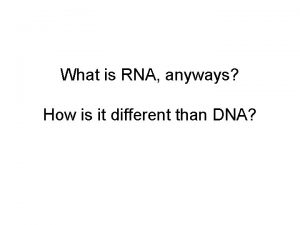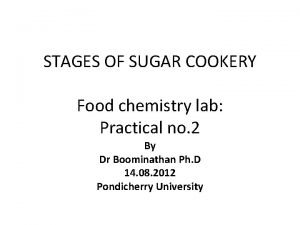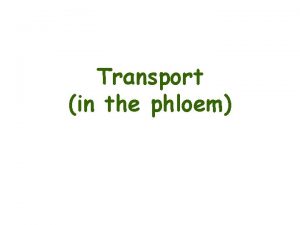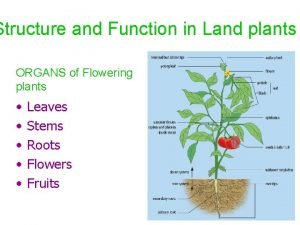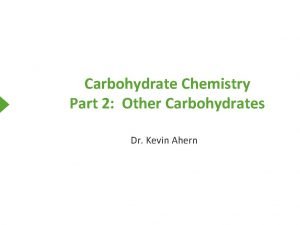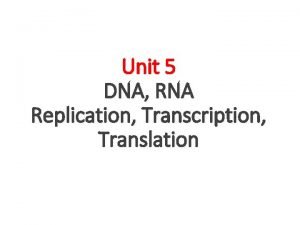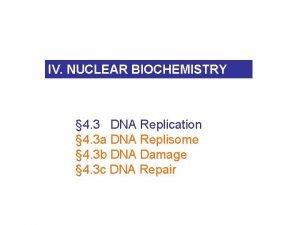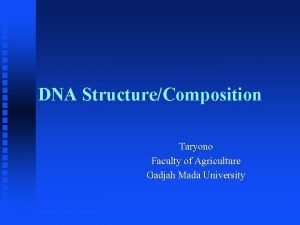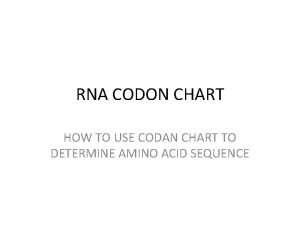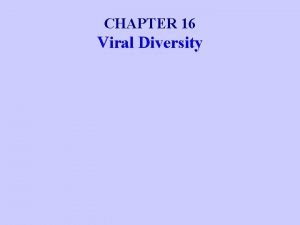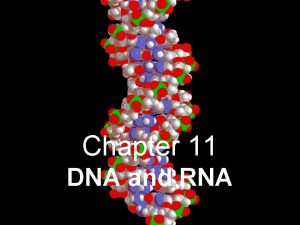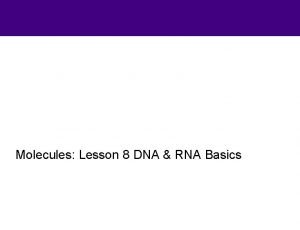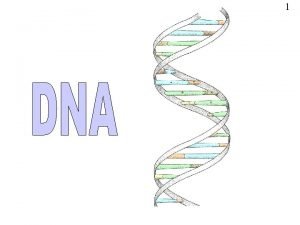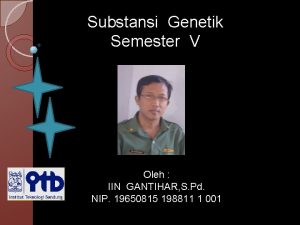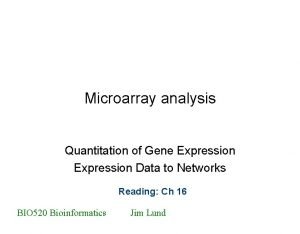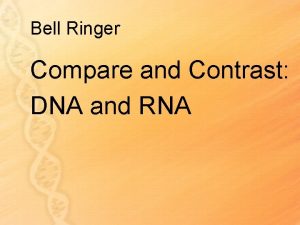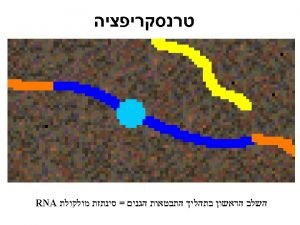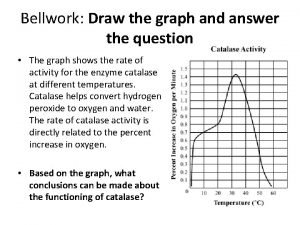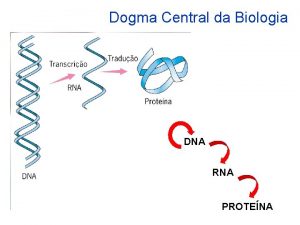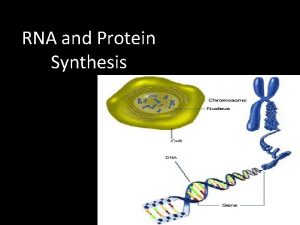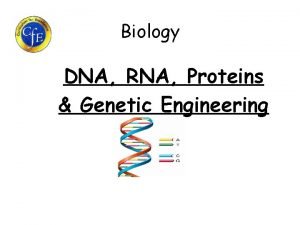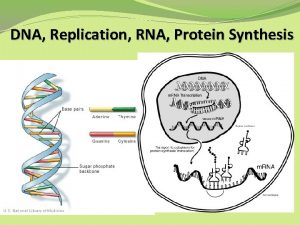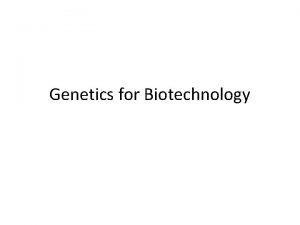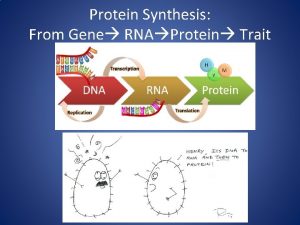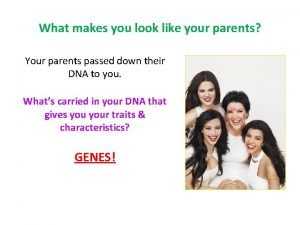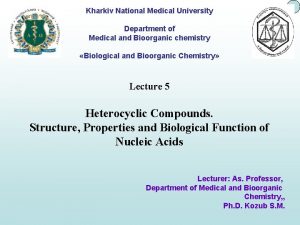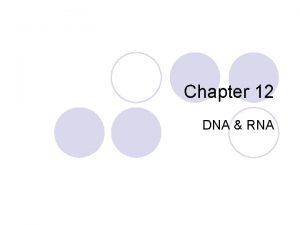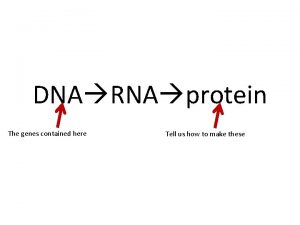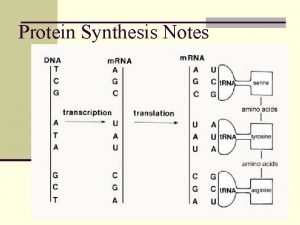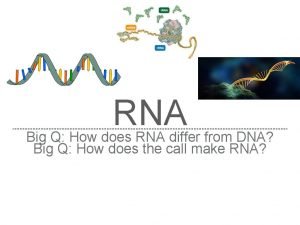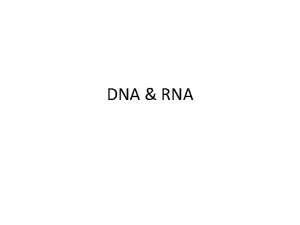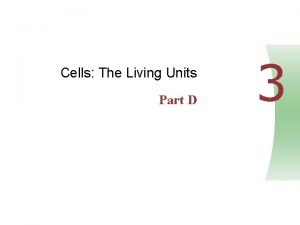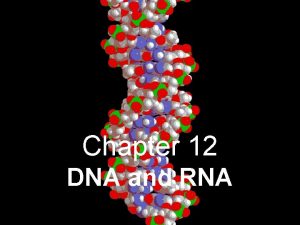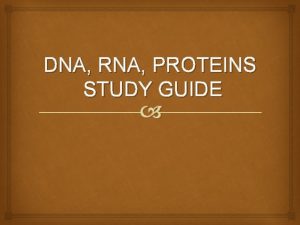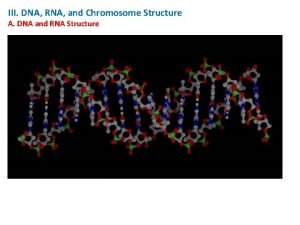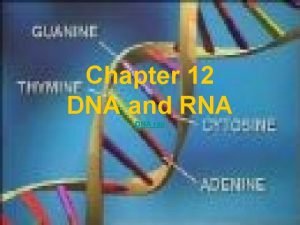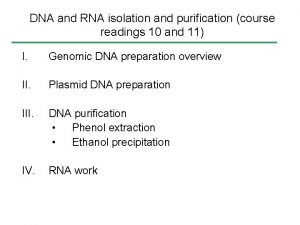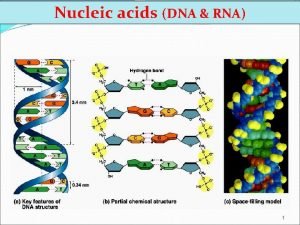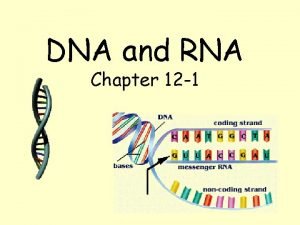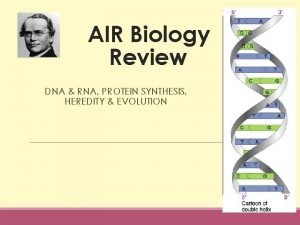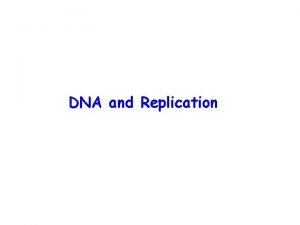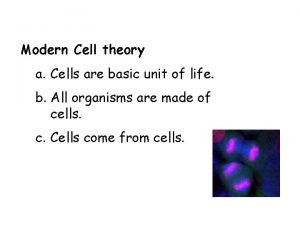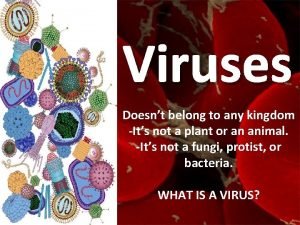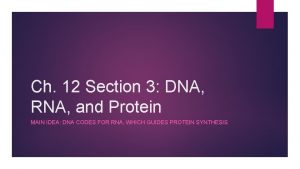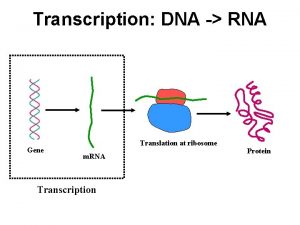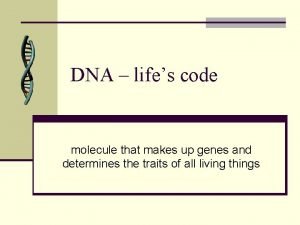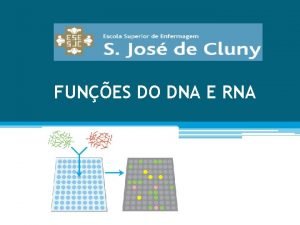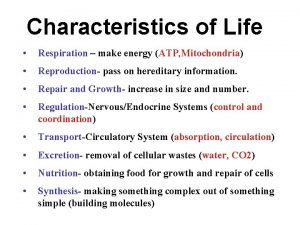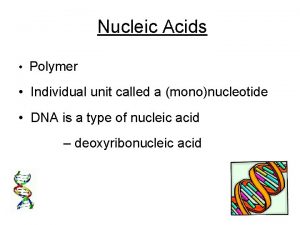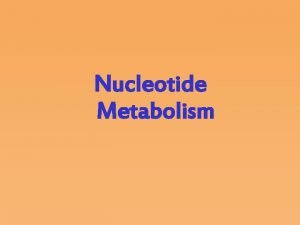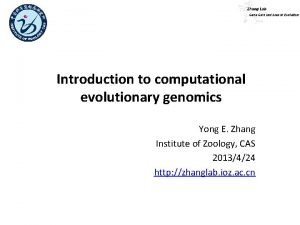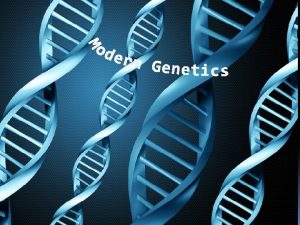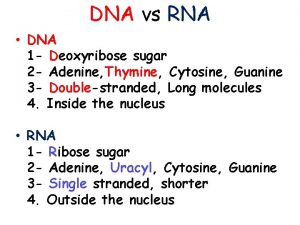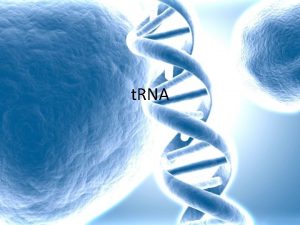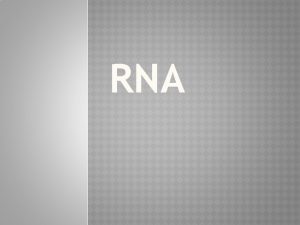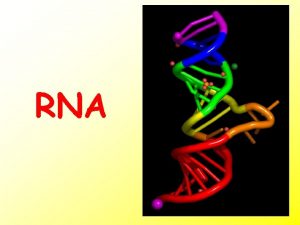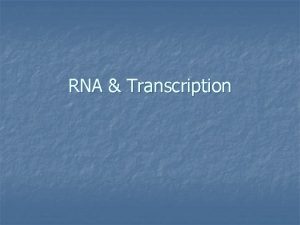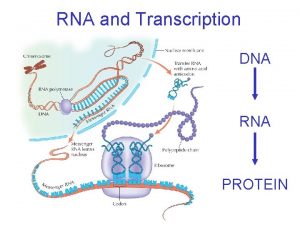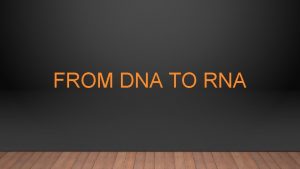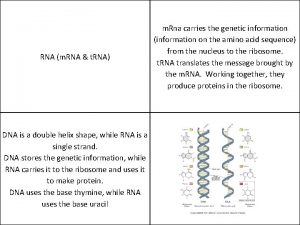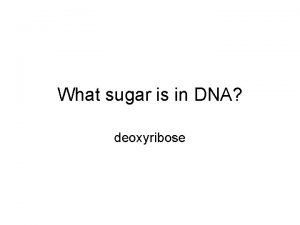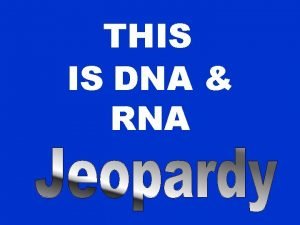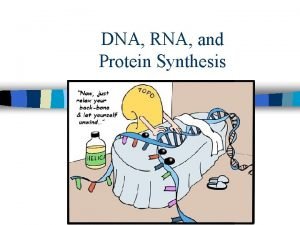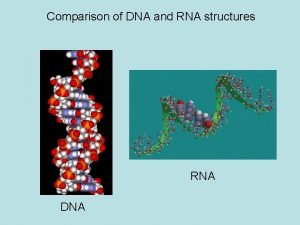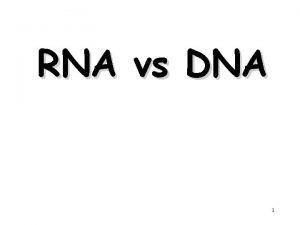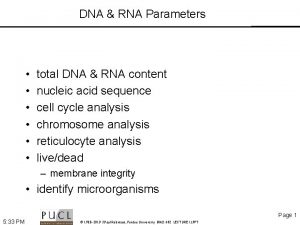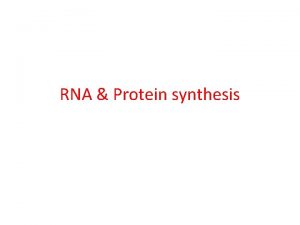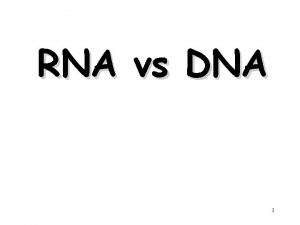RNA Nucleotide DNA Nucleotide RNA Nucleotide Sugar is



































































- Slides: 67



RNA Nucleotide DNA Nucleotide

RNA Nucleotide • Sugar is ribose • Bases include: • Adenine • Guanine • Cytosine • Uracil DNA Nucleotide • Sugar is deoxyribose • Bases include: • Adenine • Guanine • Cytosine • Thymine

• Overall Shape: • Double Helix • (looks like a twisted ladder)

• Nitrogen containing bases: • Adenine (A) • Thymine (T) • Cytosine (C) • Guanine (G)

• Base Pairing Rules: • Adenine to Thymine • (A – T) • Cytosine to Guanine • (C to G)

• Backbone: • Phosphate • Sugar (deoxyribose)

• Chargaff’s Rules: • Amount of A always equals amount of T • Amount of C always equals amount of G

§ 2 meters of DNA in each cell of your body §DNA wraps around histone proteins to form chromatin §Before cell division, chromatin winds up (condenses) to form chromosomes



RNA Structure § Single stranded § Sugar = ribose § Bases: § Adenine § Cytosine § Guanine § Uracil DNA Structure § Double stranded § Sugar = deoxyribose § Bases: § Adenine § Cytosine § Guanine § Thymine

§ Messenger RNA (m. RNA) § Carries DNA messages from nucleus to ribosome § Ribosomal RNA (r. RNA) § Makes up part of the ribosome § Transfer RNA (t. RNA) § Reads m. RNA and carries the correct amino acid to the ribosome

§ Instructions for making/controlling all things in the cell


§General Description: § Process of making an exact copy of DNA.

§ Process: 1. Original DNA strands separate 2. Complementary nucleotides attach § Use base pairing rules 3. Backbone formed to create new strand § Sugar and phosphates bond together 4. End Result: Two identical DNA molecules § Each has one original strand one new strand

§Identify the structures 1. 2. 3. 4. Original DNA strands Complementary nucleotides DNA Polymerase (enzyme) Newly constructed DNA Strand

§DNA Replication occurs during the Synthesis (S) phase of the cell cycle

§Terminology: § Transcription: Process of copying a DNA message onto an m. RNA molecule. § Translation: Process of translating the message on an m. RNA into a protein. § m. RNA: Carries the DNA message to the ribosome. § t. RNA: reads the m. RNA message and brings amino acids to the ribosome.

§r. RNA: makes up part of the ribosome. §Codon: 3 letter “word” on m. RNA that codes for an amino acid §Anticodon: 3 letter “word” on t. RNA that matches the codon §Ribosome: structure in the cell where proteins are made

1. 2. 3. 4. 5. DNA Transcription m. RNA Translation Protein

§Example: §DNA: §m. RNA: §Amino Acid: TAC CGG AUG GCC Met Ala TAA CGC AUU GCG Ile Ala

§ DNA determines sequence of m. RNA § m. RNA is grouped into “codons” of 3 letters § Each codon corresponds to a specific amino acid § t. RNA brings the correct amino acid to the ribosome § Amino acids link together to make a protein

Transcription Drawing

Translation Drawing



1. Interphase 2. Gap 1 (G 1) Phase § Does normal cell things, Cell grows, makes more organelles 3. Synthesis (S) phase § DNA Replication occurs 4. Gap 2 (G 2) phase § Preparation for cell division

5. Cell Division (M-phase) 6. Mitosis 7. Cytokinesis 8. Prophase 9. Metaphase 10. Anaphase 11. Telophase 12. Cytokinesis

Step 1: Interphase Purpose: Prepare the cell Gap 1 (G 1): § Normal cell things § Cell grows and copies organelles § Synthesis (S): § DNA Replication occurs § Gap 2 (G 2): § Preparing for cell division § § §

Step 2: Mitosis § Purpose: divide the nucleus

§ Prophase: § Chromosomes condense § Nuclear envelope disappears § Spindle fibers form § Metaphase: § Chromosomes line up along equator (middle)

§ Anaphase: § Chromosomes pulled to opposite ends of cell by spindle fibers § Telophase: § Chromosomes uncoil § Nuclear envelope re-appears § Spindle fibers disappear

Step 3: Cytokinesis § Purpose: divide the cell (cytoplasm) § Occurs after telophase when there are two nuclei in the cell

Step 3: Cytokinesis § In plants: § Cell plate forms down middle of cell § Cells break apart

Step 3: Cytokinesis § In animals: § Cell membrane pinches in § Cells pinch apart


Why we need cell division: § Growth § Growing from a single cell to an adult requires more cells

Why we need cell division: § Replace dead/injured cells § Cells must be replaced as they are lost § Example: skin cells constantly shed and must be replaced

Why we need cell division: § Replace cells after illness § Immune responses destroy healthy and sick cells


PMAT §P=Prophase §M=Metaphase §A=Anaphase §T=Telophase

Parent Cell: Interphase • Diploid • Somatic (body) cell • DNA is copied Prophase: • Chromosomes condense • Nuclear envelope disappears • Spindle fibers form

Metaphase: • Chromosomes line up along equator (middle) • Chromosomes attached to spindle fibers Anaphase: • Chromosomes pulled apart by spindle fibers

Telophase: • Chromosomes uncoil • Nuclear envelopes reappear • Spindle fibers disappear



1 st division of Meiosis: • Almost identical to mitosis • Difference = chromatids on homologous chromosomes can switch • Called crossing over

2 nd division of Meiosis: • This division cuts chromosome # in half • Still similar to mitosis • Difference: end up with 4 unique haploid cells

Purpose of Meiosis: • To create gametes or sex cells that are haploid Importance of creating haploid cells: • A gamete has to fuse with another gamete to make a new individual (fertilization) • If each had full set of chromosomes, the new individual would have twice as many chromosomes

How does each sex cell become unique: • Chromosomes line up randomly • Crossing over occurs

Fertilization: • Fusion of gametes to create a new individual

Egg and Sperm each created through meiosis Egg and Sperm combine during Fertilization creates a new individual Egg = Haploid Sperm = Haploid Egg(haploid) + Sperm(haploid) = New Individual Cell (diploid)

Somatic Cells Gametes: • Body Cells • Diploid • Sex Cells (egg or sperm) • Haploid

1. Autosomes • Regular chromosomes • 22 pairs in humans

2. Homologous Chromosomes • A pair of chromosomes • 1 from mom • 1 from dad • Same genes on each one; just different versions

3. Sex Chromosomes • 23 rd or last pair in humans • Determine gender • Females have XX • Males have XY

Diploid Cell: Haploid Cell: • Has 2 copies of each chromosome 1 from mom’s egg • Has 1 copy of each chromosome 1 from dad’s sperm • These are somatic cells • These are gametes Egg for females Sperm for males

Diploid Haploid

1. 2. 3. 4. 5. Mitosis vs. Meiosis Mitosis Meiosis Makes diploid cells 1. Makes haploid cells Creates identical 2. Creates unique cells Makes somatic cells 3. Makes gametes Used to grow & heal 4. Used to create sex cells for reproduction Cell divides once 5. Cell divides twice

Mitosis: Diploid Parent Cell DNA Replication Nucleus then cell divides Diploid daughter cells

Meiosis Part I: Diploid Parent Cell DNA Replication Nucleus then cell divides Diploid daughter cells

Meiosis Part II: Cell divides again Diploid daughter cells from 1 st division Haploid daughter cells

Haploid Diploid Human 23 46 Earthworm 18 36

Egg/Sperm Zygote Maize (corn) 10 20 Dog 36 78
 Chapter 11 dna and genes
Chapter 11 dna and genes Diagram of nucleotide
Diagram of nucleotide Stages of cooking sugar
Stages of cooking sugar Source to sink plants
Source to sink plants Reducing and non reducing sugar
Reducing and non reducing sugar Sugar source vs sugar sink
Sugar source vs sugar sink Reducing vs non reducing sugars
Reducing vs non reducing sugars Nucleoside and nucleotide
Nucleoside and nucleotide Bioflix activity dna replication lagging strand synthesis
Bioflix activity dna replication lagging strand synthesis Ribonucleotide vs deoxyribonucleotide
Ribonucleotide vs deoxyribonucleotide Dna nucleotide
Dna nucleotide Nucleotide in dna replication
Nucleotide in dna replication Sugar phosphate backbone of dna
Sugar phosphate backbone of dna Amino acids sequence chart
Amino acids sequence chart Corona virus dna or rna
Corona virus dna or rna Chargaff
Chargaff Fraction
Fraction Dna and rna
Dna and rna Dna number of strands
Dna number of strands Substansi genetik dna dan rna mempunyai kesamaan yaitu
Substansi genetik dna dan rna mempunyai kesamaan yaitu Why dna is more stable than rna?
Why dna is more stable than rna? Microarray analysis
Microarray analysis Rna transfer
Rna transfer Rna or dna
Rna or dna Dna to rna rules
Dna to rna rules Dna
Dna Dna and rna venn diagram
Dna and rna venn diagram Dna and rna
Dna and rna Lenine
Lenine Central dogma
Central dogma Protein
Protein Dna rna protein central dogma
Dna rna protein central dogma Dna vs rna
Dna vs rna Section 12-1 dna
Section 12-1 dna Dna rna protein
Dna rna protein Unlike dna, rna
Unlike dna, rna Virusmax
Virusmax Big q
Big q Transcription translation venn diagram
Transcription translation venn diagram Dna and rna structure
Dna and rna structure Dna to rna transcription
Dna to rna transcription Rantai dna yang berperan sebagai beton untuk rna adalah
Rantai dna yang berperan sebagai beton untuk rna adalah Chapter 12 dna and rna
Chapter 12 dna and rna Dna rna and proteins study guide answers
Dna rna and proteins study guide answers Rna types
Rna types Dehydration synthesis dna
Dehydration synthesis dna Differences between dna and rna
Differences between dna and rna Dna rna
Dna rna Dna rna protein diagram
Dna rna protein diagram Cytoplasm structure
Cytoplasm structure Rna and protein synthesis study guide
Rna and protein synthesis study guide Nucleic acid
Nucleic acid Chapter 12 dna and rna section 12-1
Chapter 12 dna and rna section 12-1 Dna and rna coloring worksheet
Dna and rna coloring worksheet Minor groove
Minor groove What is the process called
What is the process called What does dna have that rna doesnt
What does dna have that rna doesnt Chapter 12 section 3 dna rna and protein
Chapter 12 section 3 dna rna and protein Rna
Rna What is the goal of replication
What is the goal of replication Dna e rna
Dna e rna Replication fork
Replication fork Coding dna and non coding dna
Coding dna and non coding dna What role does dna polymerase play in copying dna?
What role does dna polymerase play in copying dna? Deoxyribose nucleotide
Deoxyribose nucleotide Nucleotide structure
Nucleotide structure De novo synthesis vs salvage pathway
De novo synthesis vs salvage pathway Single nucleotide polymorphism (snp)
Single nucleotide polymorphism (snp)

